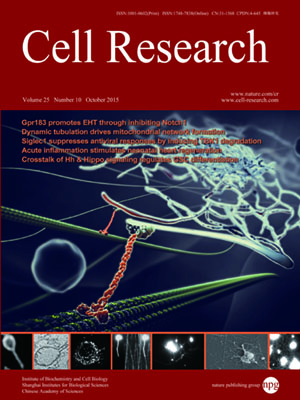
Volume 25, No 10, Oct 2015
ISSN: 1001-0602
EISSN: 1748-7838 2018
impact factor 17.848*
(Clarivate Analytics, 2019)
Volume 25 Issue 10, October 2015: 1137-1151 | Open Access
ORIGINAL ARTICLES
Acute inflammation stimulates a regenerative response in the neonatal mouse heart
Chunyong Han1,*, Yu Nie1,*, Hong Lian1, Rui Liu1, Feng He1, Huihui Huang1 and Shengshou Hu1
1State Key Laboratory of Cardiovascular Disease, Fuwai Hospital, National Center for Cardiovascular Disease, Chinese Academy of Medical Sciences and Peking Union Medical College, Beijing 100037, China
Correspondence: Shengshou Hu, Tel: +86-10-88396011; Fax: +86-10-88398359 E-mail: shengshouhu@yahoo.com; Yu Nie, Tel: +86-10-60866139; Fax: +86-10-60866092(nieyuniverse@126.com)
Cardiac injury in neonatal 1-day-old mice stimulates a regenerative response characterized by reactive cardiomyocyte proliferation, which is distinguished from the fibrotic repair process in adults. Acute inflammation occurs immediately after heart injury and has generally been believed to exert a negative effect on heart regeneration by promoting scar formation in adults; however, little is known about the role of acute inflammation in the cardiac regenerative response in neonatal mice. Here, we show that acute inflammation induced cardiomyocyte proliferation after apical intramyocardial microinjection of immunogenic zymosan A particles into the neonatal mouse heart. We also found that cardiac injury-induced regenerative response was suspended after immunosuppression in neonatal mice, and that cardiomyocytes could not be reactivated to proliferate after neonatal heart injury in the absence of interleukin-6 (IL-6). Furthermore, cardiomyocyte-specific deletion of signal transducer and activator of transcription 3 (STAT3), the major downstream effector of IL-6 signaling, decreased reactive cardiomyocyte proliferation after apical resection. Our results indicate that acute inflammation stimulates the regenerative response in neonatal mouse heart, and suggest that modulation of inflammatory signals might have important implications in cardiac regenerative medicine.
10.1038/cr.2015.110
FULL TEXT | PDF
Browse 2200


